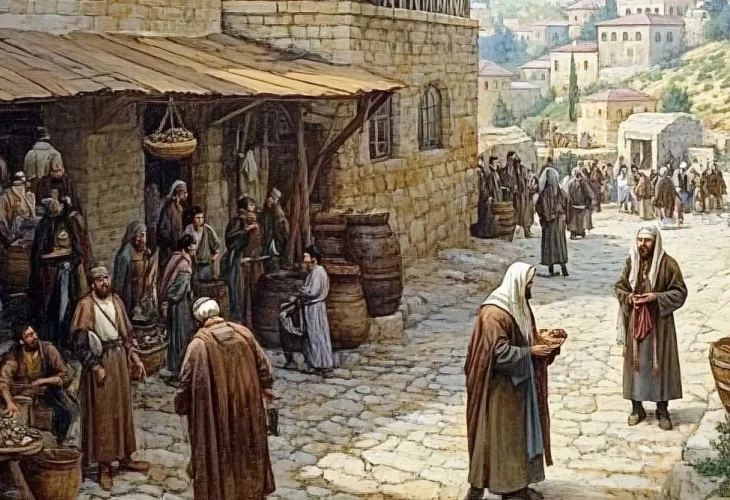Reviving an Ancient Land: A Historic Jewish Settlement Renaissance
In an era of tribal unrest, Bedouin leader Daher el-Omar sought to develop the land and welcomed Jewish settlers known for their deep connection to Israel.

In the latter half of the 18th century, a wave of Jewish collective immigration began to take shape. Historian Prof. Mordechai Eliav writes, "From the mid-18th century, the seeds of the future began to sprout. Individual immigrations became organized groups, and the continuous influx strengthened the Jewish settlement, expanded its map, and laid the foundations for its renewal."
At that time, the Jewish community consisted of a few thousand individuals, mainly concentrated in the four holy cities: Jerusalem, Safed, Tiberias, and Hebron—about six thousand souls in total. All of these Jews were observant, their livelihoods partly supported by donations from devout Jews abroad, who wished to fulfill the mitzvah of settling the Promised Land by supporting their brethren living there. Thus, both settlement and its support stemmed from religious-ideological motives.
The Zionist movement began much later—only at the end of the 19th century (the First Zionist Congress in Basel—1897), and its initial activity in the Land began only in the early 20th century (establishment of the Jewish Agency—1908).
Thus, in the mid-18th century, around 1740, by the year 5500 according to the Jewish calendar, the Bedouin Sheikh Daher el-Omar took control of the region, aspiring to develop it, knowing he had to suppress the Bedouin robber tribes ruling the area unchecked. But who would dare to settle this perilous land? Only the Jews, renowned for their love for the Land of Israel. Eliav notes, "He favored the Jews and had ambitious developmental plans. He invited Rabbi Chaim Abulafia, the rabbi of Izmir, to rebuild Tiberias from its ruins." Rabbi Chaim, besides spearheading construction, "formulated plans to encourage productive sources of livelihood and agriculture. He revitalized agricultural communities in Kfar Yasif, Shfaram, and Peki'in, and endeavored to stimulate Aliyah, viewing Daher's invitation as a harbinger of redemption."
Indeed, the news of Tiberias's reconstruction spurred an upswing in Aliyah and increased donations abroad.
Prof. Eliav writes, "Daher's support contributed significantly to the settlement efforts that paved the way for the organized immigrations at the end of the century."
Here are some notable figures who immigrated during this revitalization in the 18th century:
1741 – Rabbi Elazar Rokeach, author of "Maaseh Rokeach," immigrated from Amsterdam.
1742 – Rabbi Chaim ben Attar, author of the "Or HaChaim" commentary on the Torah, arrived with a group of immigrants, establishing a yeshiva in Jerusalem.
1743 – Rabbi Moshe Chaim Luzzatto (the Ramchal) immigrated to the Land of Israel.
1747 – Rabbi Gershon Kitover, brother-in-law of the Baal Shem Tov, immigrated after the Baal Shem Tov himself returned from an unfulfilled attempt due to unknown reasons. Tradition among his disciples said he reached Constantinople and turned back.
Prof. Eliav states, "The growing Torah study in Jerusalem attracted a significant number of scholars, briefly reestablishing Jerusalem as a center of Torah for the diaspora. This growth became a source of irritation for the rulers."
1758 – Two disciples of the Baal Shem Tov, Rabbi Nachman of Horodenka and Rabbi Menachem Mendel of Permishlan, arrived in Safed with a small group.
1778 – A large group of 300 Hasidim immigrated to Safed, led by three disciples of the Mezritcher Maggid: Rabbi Menachem Mendel of Vitebsk, Rabbi Yisroel of Plotsk, and Rabbi Avraham of Kalisk.
1781 – Rabbi Binyamin Rivlin and his son Rabbi Hillel conducted promotional journeys in Jewish communities across Russia, Poland, and Lithuania, sparking interest in Zion's return. Guided by the Vilna Gaon, they founded a movement named "Vision of Zion," aiming to organize a mass return to Zion. That year, Rabbi Azriel of Shklov was sent to the Land by the disciples of the Vilna Gaon to study the questions of Aliyah and settlement.
A century before the establishment of the "Hovevei Zion" societies, which emerged following the 1881-2 pogroms, there was already activity in the diaspora promoting Aliyah, without the threat of pogroms. This Aliyah explicitly aimed to advance redemption by settling and redeeming the Land. These were the original, true Zionists.
Prof. Mordechai Eliav asserts: "Had the settlement of the four holy cities not preceded, the first colonies would not have emerged, and in 1920, Lloyd George (then British Prime Minister) told the Yishuv delegation: without those Hebrew settlements 30 years prior, the Balfour Declaration<\/span>would never have come into existence<\/span>".<\/p>

